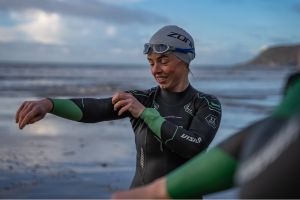The effects of cold water on your body
Written by Chloe Rafferty, Director of Love SwimRun and STA Open Water Swimming Coach.

Cold Water Incapacitation
When you are immersed in cold water your body continually looses heat and blood shunts to the core to keep your organs warm. As a result, blood flow to your extremities is reduced and your muscles begin to lose power, limbs become slow and heavy, you start to feel very tired and swimming becomes increasingly difficult. You will eventually lose your ability to control your hands and keep your fingers together (clawed hands) and the muscles in your arms and legs will stop working well enough to keep you above water – staying afloat can become very difficult. As soon as you start to notice the first signs of cold water incapacitation you should finish your swim!
Hypothermia & How To Recognise The Signs
Your core body temperature is normally between 36.5ºC and 37.5ºC. Clinical hypothermia is considered a core body temperature of 35ºC, so it only takes a small drop in temperature to put you in a serious medical condition.
Spotting the signs of hypothermia can be hard when you are in the water but these are some signs to look for in yourself and your swimming companions:
-
Shivering and cannot stop voluntarily
-
Slurred speech or mumbling, may have clenched jaws.
-
Confusion or memory loss, and may not be able to answer questions coherently. One trick is to count to 10 and then back to one, over and over again. If you lose your train of thought or lose count, it is definitely time to exit the water.
-
Stroke rate slows down and heaviness in arms.
-
Position in the water becomes more vertical and kicking slows.
-
Splashing excessively due to a deteriorating quality of arm stroke
-
Looks pale and have a blank, lost expression
-
Complaining of cold
-
A lack of reasoning and an inability to gauge their own condition. As blood cools in the body it becomes thicker so less oxygen gets carried to the brain. The resulting confusion means you are unable think clearly.
-
Teeth chattering
-
Suddenly feeling of warmth after feeling cold
-
Manual dexterity is reduced, a common symptom is splayed fingers and the inability to keep them together when swimming, know as Clawed hands.
If you or anyone you are swimming with begin to experience any of these symptoms get out the water immediately and begin slow rewarming (see below).
Shivering
Shivering is stimulated to increase deep body temperature when a reduction in deep body temperature occurs. It works by involuntary contraction of the muscles to generate heat. A swimmer who is experiencing violent shivering (Moderate stage Hypothermia) should be removed from the water immediately. How do you tell violent shivering from normal shivering? Normal shivering can be stopped voluntarily, violent shivering can’t!
Understand ‘After Drop’ & The Safest Ways Of Re-warming
When you finish a cold water swim, your core continues to cool down for approximately 20-30 minutes. This means that your deep body temperature will be cooler 20-30 minutes after your swim than your were when you got out of the water. When you first get out of the water you may not be shivering but within a couple of minutes you may begin to shiver a lot and will feel increasingly cold. This response is known as ‘After Drop’. It can be a pretty unpleasant feeling, a bit like a creeping cold hand going down your back and then a growing cold feeling right in your middle.
It is essential that you get dry begin warming up immediately after you exit the water. The safest way to re-warm is to:
-
Remove your wet clothes and dry off as soon as possible - pat your skin rather than rub it.
-
Dress in layers of dry warm clothes, including hat gloves and thick socks – ideally lay these out in advance so you can do this quickly and avoid clothing with fiddly buttons, hooks and zips as your hands will be too cold to deal with them.
-
Focus on covering your head and core dressed first.
-
If you are changing outdoors have a insulated mat to stand on
-
Put on a hat over your swim hat to avoid any further heat loss until you have finished dressing.
-
Have a warm sugary drink ready in a flask. Just warm is best as hot liquid on very cold lips can feel scolding. Only half fill your cup or use a cup with a lid as when you shiver you may spill your drink!
-
Shivering is good – it is your body’s way of generating internal heat.
-
Eat high carbohydrate food to replace the energy you have lost. Your body needs energy to keep producing heat!
-
Get out of any wind and preferably into a warm indoor environment.
-
Use a hot water bottle or heated car seat to gently help add warmth.
-
Do not drive until you have warmed up properly.
-
Do not jump straight into a hot tub or hot bath/shower! This can exacerbate the effect of After Drop and can be painful. Your body needs to rewarm slowly and naturally.
Keep your eye out for Part 4 - Swim safely through winter














 Creating world class triathlon kit since 2006
Creating world class triathlon kit since 2006
 Free delivery on orders over £75, next day available
Free delivery on orders over £75, next day available
 Fast and Free returns
Fast and Free returns
 Rated excellent 4.5 out of 5 from over 3,500+ reviews
Rated excellent 4.5 out of 5 from over 3,500+ reviews









